tow PONTIAC FIREBIRD 1998 Owners Manual
[x] Cancel search | Manufacturer: PONTIAC, Model Year: 1998, Model line: FIREBIRD, Model: PONTIAC FIREBIRD 1998Pages: 406, PDF Size: 18.23 MB
Page 14 of 406

Head Restraints
Slide the head restraint up or down so that the top of the
restraint
is closest to the top of your ears. This position
reduces the chance
of a neck injury in a crash.
On some models, the head restraints tilt forward and
rearward also.
Front Seatback Latches
The front seatback folds
forward to let people get
into the back seat.
To fold a
seatback
forward, push the
seatback toward the rear as
you lift this latch. Then the
seatback will fold forward. When you return the seatback to
its original position,
make sure the seatback is locked. The latch must be
down for the seat to work properly.
' A CAUTION:
If the seatback isn't locked, it could move
forward in
a sudden stop or crash. That could
cause injury to the person sitting there.
Always press rearward on the seatback
to be
sure it is locked.
1-7
Page 33 of 406

How does an air bag restrain?
In moderate to severe fi-ontal or near-frontal collisions,
even
bdted occupants can contact the steering wheel or the
instrument panel.
Air bags supplement the protection
provided by safety belts.
Air bags distribute the force of
the impact more evenly over the occupant’s upper body,
stopping the occupant more gradually. But
air bags would
not help you in many types of collisions, including
rollovers, rear impacts and side impacts, primarily because an occupant’s motion is not toward those
air bags. Air
bags should never be regarded as an-g more than a
supplement to safety
belts, and then only in moderate to
severe fi-ontal or near-frontal collisions.
What will you see after an air bag inflates?
After an air bag inflates, it quickly deflates, so
quickly that some people may not even realize the air
bag inflated. Some components of the air bag
module
-- the steering wheel hub for the driver’s
air bag, or the instrument panel for the right front
passenger’s bag
-- will be hot for a short time. The
parts of the bag that come into contact with you may
be
warm, but not too hot to touch. There will be some
smoke and dust coming from vents
in the deflated air
bags.
Air bag inflation doesn’t prevent the driver from
seeing or from being able to steer the vehicle, nor does it
stop people from leaving the vehicle.
When an air bag inflates, there is dust in the air.
This dust could cause breathing problems for
people with a history
of asthma or other
breathing trouble.
To avoid this, everyone in the
vehicle should get out as soon as it is
safe to do so.
If you have breathing problems but can’t get out
of the vehicle after an air bag inflates, then get
fresh air
by opening a window or door.
In many crashes severe enough to inflate an air bag,
windshields are broken
by vehicle deformation.
Additional windshield breakage may
also occur from
the right front passenger air bag.
Air bags are designed to inflate only once. After they
inflate, you’ll
need some new parts for your air bag
system.
If you don’t get them, the air bag system
won’t
be there to help protect you in another crash.
A new system will include
air bag modules and
possibly other parts. The service manual for your
vehicle covers the need to replace other parts.
1-26
Page 41 of 406

Child Restraints
Every time infants and young children ride in
vehicles, they should have protection provided by
appropriate restraints.
@ What are the different types of add-on
child restraints?
A: Add-on child restraints are available in four basic
types. When selecting
a child restraint, take into
consideration
not only the child’s weight and size,
but
also whether or not the restraint will be
compatible with the motor vehicle
in which it will
be used.
An infant car bed (A) is a special bed made for use
in a motor vehicle. It’s an infant restraint system
designed to
restrain or position a child on a
continuous flat surface. With an infant car bed,
make sure that the infant’s head rests toward the
center of the vehicle.
1-34
Page 53 of 406

@ What if a child is wearing a lap-shoulder belt,
but the child is
so small that the shoulder belt is
very close to the child’s face or neck?
A: Move the child toward the center of the vehicle, but
be sure that the shoulder belt still is on the child’s
shoulder,
so that in a crash the child’s upper body
would have the restraint that belts provide.
A CAUTION: I
I
I
Here a child is sitting in a seat that has a
lap-shoulder belt, but the shoulder part is behind
the child.
If the child wears the belt in this way, in
a crash the child might slide under the belt. The
belt’s force would then be applied right on the
child’s abdomen. That could cause serious
or
fatal injuries.
Wherever the child sits, the lap portion of the belt
should be
worn low and snug on the hips, just touching
the child’s thighs.
This applies belt force to the child’s
pelvic bones in a crash.
1-46
Page 78 of 406
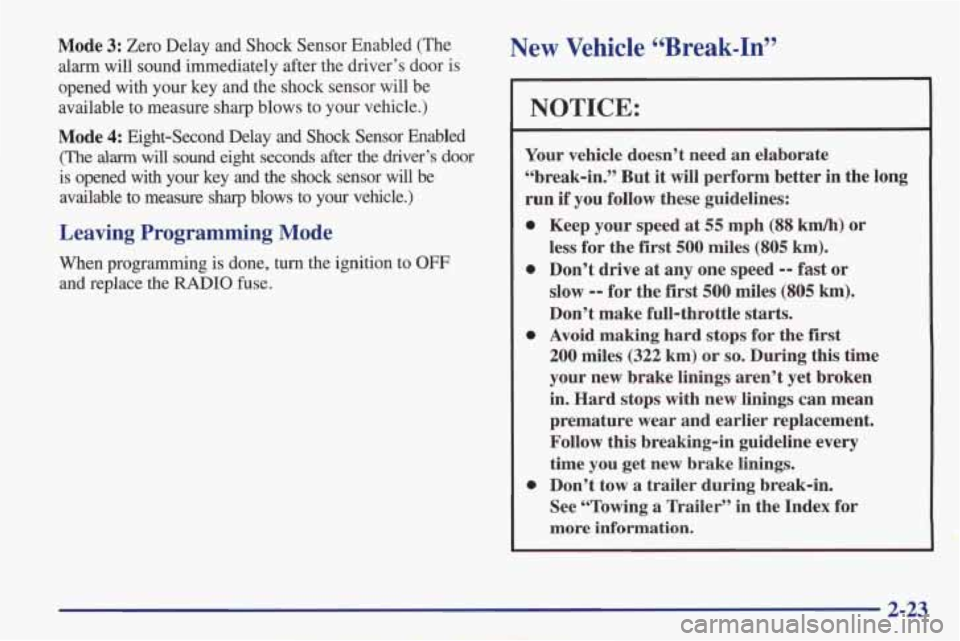
Mode 3: Zero Delay and Shock Sensor Enabled (The
alarm will sound immediately after the driver’s door is
opened with your key and the shock sensor will be
available to measure sharp blows to your vehicle.)
Mode
4: Eight-Second Delay and Shock Sensor Enabled
(The alarm will sound eight seconds after the driver’s door
is
opened with your key and the shock sensor will be
available to measure sharp blows to your vehicle.)
Leaving Programming Mode
When programming is done, turn the ignition to OFF
and replace the RADIO fuse.
New Vehicle CCBreak-InS’
NOTICE:
Your vehicle doesn’t need an elaborate
“break-in.” But it will perform better
in the long
run
if you follow these guidelines:
0 Keep your speed at 55 mph (88 km/h) or
less for the
first 500 miles (805 km).
0 Don’t drive at any one speed -- fast or
slow
-- for the first 500 miles (805 km).
Don’t make full-throttle starts.
200 miles (322 km) or so. During this time
your new brake linings aren’t yet broken
in. Hard stops with new linings can mean
premature wear and earlier replacement.
Follow this breaking-in guideline every
time you get new brake linings.
See “Towing a Trailer’’ in the Index for
more information.
0 Avoid making hard stops for the first
0 Don’t tow a trailer during break-in.
2-23
Page 79 of 406

Ignition Positions
C
1
A i E
With the ignition key in the ignition, you can turn the
switch to five positions.
ACC (A): Position in which you can operate your
electrical power accessories. Push in the ignition switch
as you turn
it toward you.
LOCK (B): The only position from which you can
remove the key. This locks your steering wheel, ignition
and automatic transmission.
If you have an automatic transmission, the ignition
switch can’t be turned to
LOCK unless the shift lever is
in
PARK (P).
OFF (C): Unlocks the steering wheel, ignition and
automatic transmission, but does not send electrical
power to any accessories. Use this position if your
vehicle must be pushed or towed.
A warning tone will
sound
if you open the driver’s door when the ignition is
off and the key is in the ignition.
RUN (D): Position to which the switch returns after you
start your engine and release the switch. The switch
stays
in RUN when the engine is running. But even
when the engine
is not running, you can use RUN to
operate your electrical power accessories and to display some instrument panel warning and indicator lights.
START (E): Starts the engine. When the engine starts,
release the key. The ignition will return to RUN for
normal driving.
2-24
Page 82 of 406
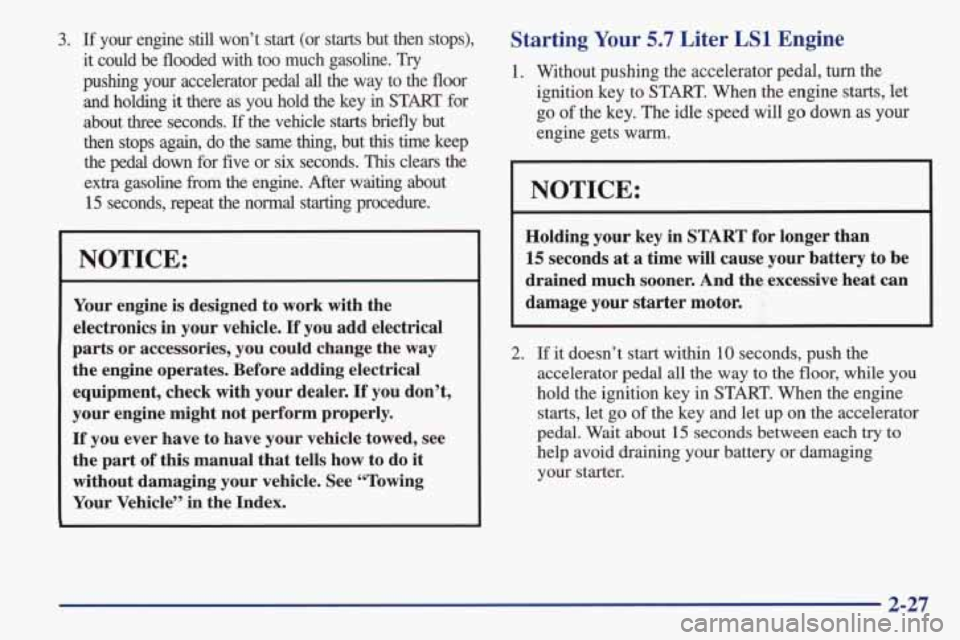
3. If your enpe still won’t start (or starts but then stops),
it could be flooded with too much gasoline. Try
pushing your accelerator pedal
all the way to the floor
and holding it there as you hold the key in START for
about three seconds. If the vehicle
starts briefly but
then stops again, do the same
thing, but this time keep
the pedal down for five
or six seconds. This clears the
extra gasoline
from the engine. After waiting about
15 seconds, repeat the normal starting procedure.
NOTICE:
Your engine is designed to work with the
electronics in your vehicle.
If you add electrical
parts or accessories, you could change the way
the engine operates. Before adding electrical
1 equipment, check with your dealer. If you don’t,
your engine might not perform properly.
If you ever have to have your vehicle towed, see
the part
of this manual that tells how to do it
without damaging your vehicle. See “Towing
~ Your Vehicle” in the Index.
Starting Your 5.7 Liter LS1 Engine
1. Without pushing the accelerator pedal, turn the
ignition key to START. When the engine starts, let
go of the key. The idle speed will go down as your
engine gets warm.
I
NOTICE:
Holding your key in START for longer than
15 seconds at a time will cause your battery to be
drained much sooner. And the excessive heat can
damage your starter motor.
2. If it doesn’t start within 10 seconds, push the
accelerator pedal all the way to the
floor, while you
hold the ignition key in START. When the engine starts, let
go of the key and let up on the accelerator
pedal. Wait about
15 seconds between each try to
help avoid draining your battery
or damaging
your starter.
2-27
Page 83 of 406
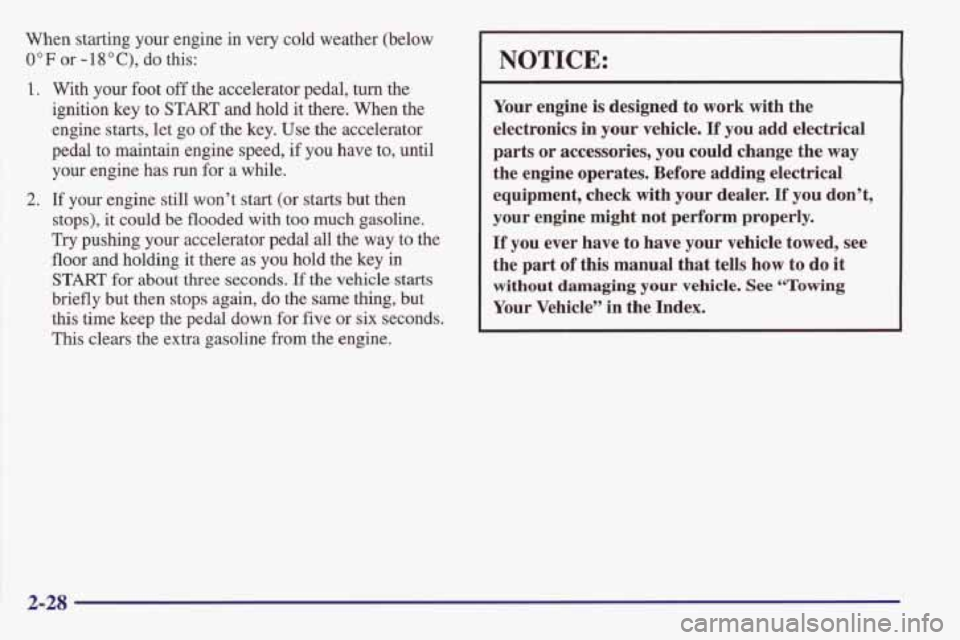
When starting your engine in very cold weather (below
0°F or -18”C), do this:
1. With your foot off the accelerator pedal, turn the
ignition key to
START and hold it there. When the
engine starts, let
go of the key. Use the accelerator
pedal to maintain engine speed, if you have to, until your engine has run
for a while.
2. If your engine still won’t start (or starts but then
stops), it could be flooded with
too much gasoline.
Try pushing your accelerator pedal all the way to the
floor and holding it there as you hold the key in
START for about three seconds. If the vehicle starts
briefly but then stops again, do the same thing, but
this time keep the pedal down for five or six seconds.
This clears the extra gasoline from the engine.
NOTICE:
Your engine is designed to work with the
electronics in your vehicle.
If you add electrical
parts or accessories, you could change the way
the engine operates. Before adding electrical
equipment, check
with your dealer. If you don’t,
your engine might not perform properly.
If you ever have to have your vehicle towed, see
the part
of this manual that tells how to do it
without damaging your vehicle. See “Towing
Your Vehicle” in the Index.
2-28
Page 86 of 406
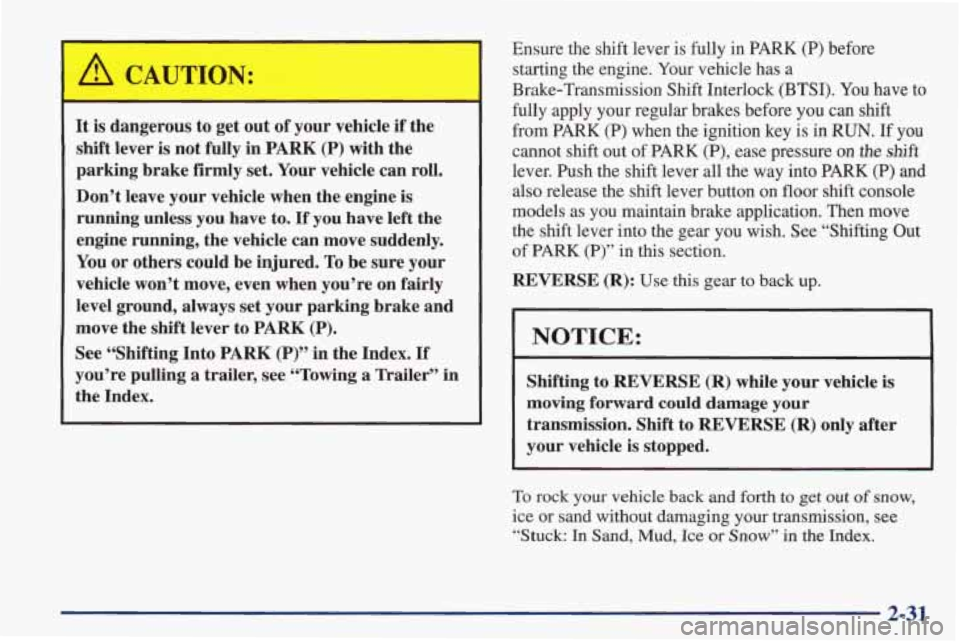
A CAUTION:
It is dangerous to get out of your vehicle if the
shift lever is not fully in PARK (P) with the
parking brake firmly set. Your vehicle can roll.
Don’t leave your vehicle when the engine is
running unless you have to.
If you have left the
engine running, the vehicle can move suddenly.
You
or others could be injured. To be sure your
vehicle won’t move, even when you’re on fairly
level ground, always set your parking brake and
move the shift lever to PARK
(P).
See “Shifting Into PARK (P)” in the Index. If
you’re pulling a trailer, see “Towing a Trailer” in
the Index. Ensure the
shift lever is fully
in PARK (P) before
starting the engine. Your vehicle has a
Brake-Transmission Shift Interlock
(BTSI). You have to
fully apply your regular brakes before you can shift
from PARK (P) when the ignition key is in RUN. If you
cannot shift out of PARK (P), ease pressure on the shift
lever. Push the shift lever all the way into PARK (P) and
also release the shift lever button on floor shift console
models as
you maintain brake application. Then move
the shift lever into the gear you wish. See “Shifting Out
of PARK (P)” in this section.
REVERSE (R): Use
this gear to back up.
I NOTICE:
Shifting to REVERSE (R) while your vehicle is
moving forward could damage your
transmission. Shift to REVERSE
(R) only after
your vehicle
is stopped.
To rock your vehicle back and forth to get out of snow,
ice or sand without damaging your transmission, see
“Stuck:
In Sand, Mud, Ice or Snow” in the Index.
2-31
Page 87 of 406
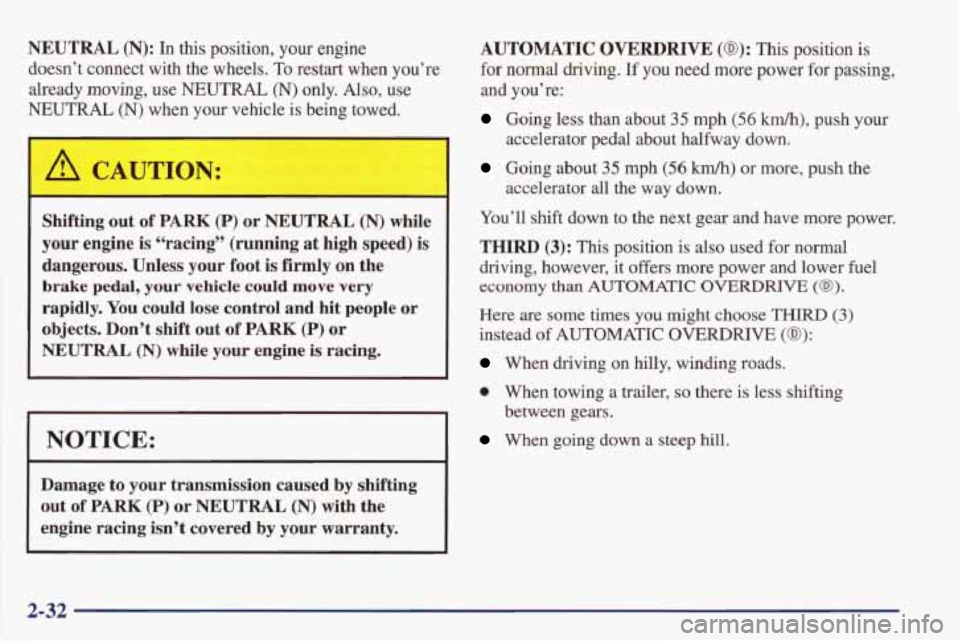
NEUTRAL (N): In this position, your engine
doesn’t connect with the wheels.
To restart when you’re
already
moving, use NEUTRAL (N) only. Also, use
NEUTRAL (N) when your vehicle is being towed.
Shifting out
of PARK (P) or NEUTRAL (N) while
your engine is “racing” (running
at high speed) is
dangerous. Unless your foot
is firmly on the
brake pedal, your vehicle could move very
rapidly. You could lose control and hit people or
objects. Don’t shift out
of PARK (P) or
NEUTRAL (N) while your engine is racing.
NOTICE:
Damage to your transmission caused by shifting
out
of PARK (P) or NEUTRAL (N) with the
engine racing isn’t covered by
your warranty.
I
AUTOMATIC OVERDRIVE (03): This position is
for normal driving. If you need more power for passing,
and you’re:
Going less than about 35 mph (56 km/h), push your
Going about 35 mph (56 km/h) or more, push the
You’ll shift down to the next gear and have more power.
THIRD (3): This position is also used for normal
driving, however, it offers more power and lower fuel
economy
than AUTOMATIC OVERDRIVE (a).
Here are some times you might choose THIRD (3)
instead of AUTOMATIC OVERDRIVE (a):
When driving on hilly, winding roads.
0 When towing a trailer, so there is less shifting
When going down a steep hill.
accelerator pedal about halfway down.
accelerator
all the way
down.
between gears.
2-32